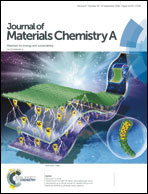Conductive molybdenum carbide as the polysulfide reservoir for lithium–sulfur batteries†
Abstract
The low electronic conductivity of sulfur and the diffusion and shuttle of polysulfide intermediates are the main obstacles of the cathode that restrain the progress of lithium–sulfur (Li–S) batteries. To address the two main predicaments, we explored a dual functional 3D hierarchical filter element structured Mo2C nanosheet based sulfur electrode. The Mo2C based sulfur electrodes fulfill the requirements of conductivity (30 S cm−1) and entrapment of diffusing polysulfide intermediates, and meanwhile possess the advantages of high crystallinity and large specific surface area. As a filter and reservoir for polysulfides, Mo2C nanosheets possess a strong chemical interaction with polysulfides to mitigate the shuttling of polysulfides. The dual functional Mo2C nanosheet based electrode exhibited a high initial discharge capacity of ca. 1200 mA h g−1 and ca. 800 mA h g−1 after 300 cycles at 0.2C. Moreover, the flexibility of the sulfur electrode is explored through an in situ fabrication on carbon cloth in a soft-package configuration.



 Please wait while we load your content...
Please wait while we load your content...